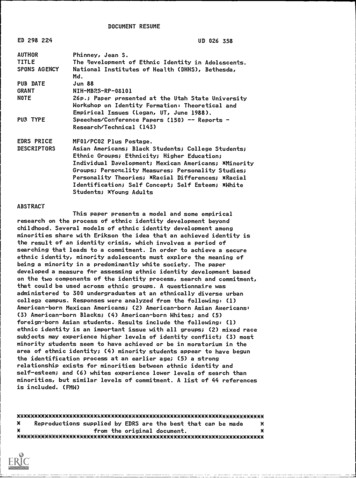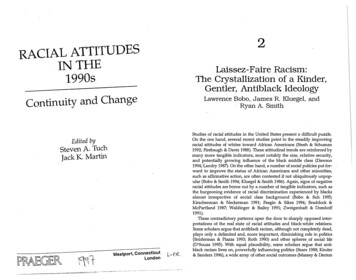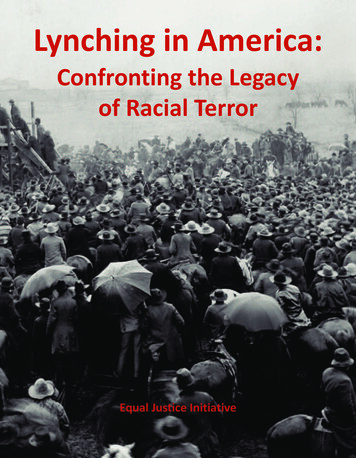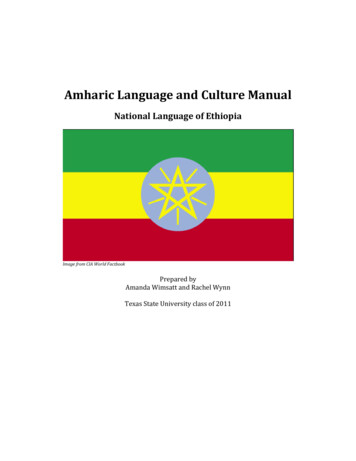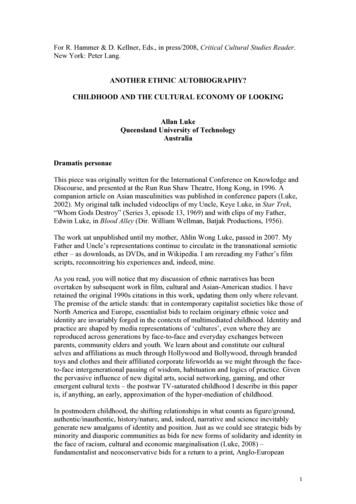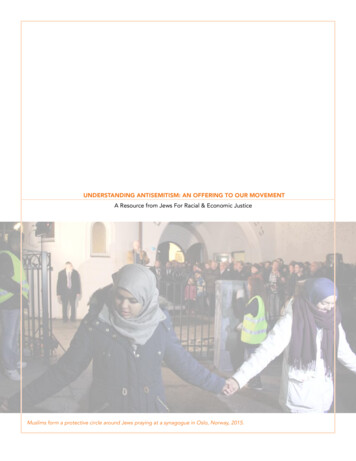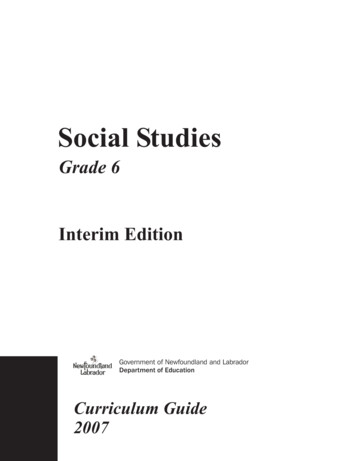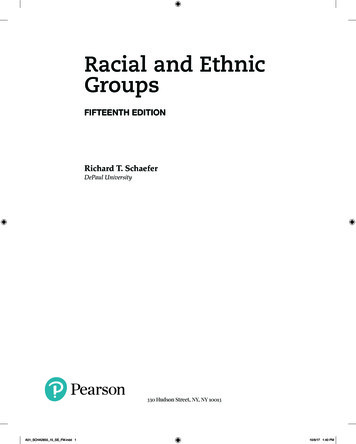
Transcription
Racial and EthnicGroupsFIFTEENTH EDITIONRichard T. SchaeferDePaul University330 Hudson Street, NY, NY 10013A01 SCHA2855 15 SE FM.indd 110/6/17 1:40 PM
Cover Designer: Jennifer Hart DesignCover Photo: John Lund/Getty ImagesManufacturing Buyer: Mary Ann GloriandePrinter/Binder: LSC Communications, Inc.Cover Printer: Phoenix Color/HagerstownPortfolio Manager: Jeff MarshallDevelopment Editor: Steven RigolosiMarketing Manager: Jeremy IntalProgram Manager: Erin BoscoProject Coordination, Text Design, and ElectronicPage Makeup: Integra-ChicagoPEARSON, ALWAYS LEARNING, and REVEL are exclusive trademarks in the United States and/or other countries owned byPearson Education, Inc., or its affiliates.Unless otherwise indicated herein, any third-party trademarks that may appear in this work are the property of their respectiveowners and any references to third-party trademarks, logos, or other trade dress are for demonstrative or descriptive purposesonly. Such references are not intended to imply any sponsorship, endorsement, authorization, or promotion of Pearson’s p roductsby the owners of such marks, or any relationship between the owner and Pearson Education, Inc., or its affiliates, authors, licensees, or distributors.Library of Congress Cataloging-in-Publication DataNames: Schaefer, Richard T., author.Title: Racial and ethnic groups / Richard T. Schaefer.Description: 15th edition. Hoboken, N.J. : Pearson Higher Education, 2019.Identifiers: LCCN 2017029686 (print) LCCN 2017030879 (ebook) ISBN 9780134736525 (Revel) ISBN 9780134732855 (hardcover) ISBN 9780134736730 (softcover)Subjects: LCSH: Minorities—United States. United States—Ethnic relations. United States--Race relations. Prejudices—United States.Classification: LCC E184.A1 (ebook) LCC E184.A1 S3 2019 (print) DDC305.800973—dc23LC record available at https://lccn.loc.gov/2017029686Copyright 2019, 2015, 2012 by Pearson Education, Inc. All Rights Reserved. Printed in the United States of America.This publication is protected by copyright, and permission should be obtained from the publisher prior to any prohibitedreproduction, storage in a retrieval system, or transmission in any form or by any means, electronic, mechanical, photocopying,recording, or otherwise. For information regarding permissions, request forms and the appropriate contacts within the PearsonEducation Global Rights & Permissions Department, please visit www.pearsoned.com/permissions/.1 18Student Edition:ISBN 10:0-134-73285-5ISBN 13: 978-0-134-73285-5www.pearsonhighered.comA01 SCHA2855 15 SE FM.indd 2Books á la Carte Edition:ISBN 10:0-134-73662-1ISBN 13: 978-0-134-73662-410/6/17 1:40 PM
To my grandchildren, Matilda and Reuben,may they grow to flourishin our multicultural societyA01 SCHA2855 15 SE FM.indd 310/6/17 1:40 PM
A01 SCHA2855 15 SE FM.indd 410/6/17 1:40 PM
Brief Contents1Exploring Race and Ethnicity 2Prejudice 313Discrimination 554Immigration 785Ethnicity, Whiteness, and Religion 1036Native Americans:The First Americans 1327African Americans 1608African Americans Today 1819Latinos: Growth and Diversity 200Mexican Americans andPuerto Ricans 21910111Muslim and Arab Americans:Diverse Minorities 23812Asian Pacific Americans:An Array of Nationalities 25813Chinese Americans and JapaneseAmericans 28214Jewish Americans: The Questto Maintain Identity 30115Women: The Oppressed Majority 32216Beyond the United States:The Comparative Perspective 34417Overcoming Exclusion 364vA01 SCHA2855 15 SE FM.indd 510/6/17 1:40 PM
A01 SCHA2855 15 SE FM.indd 610/6/17 1:40 PM
ContentsFeatures xiiiPreface xvAbout the Author xxiPart I P erspectives on Racial and Ethnic Groups1Exploring Race and Ethnicity How Are We Grouped? Types of Minority Groups 146RACIAL GROUPS 6 ETHNIC GROUPS 6 Speaking OutThe Problem of the Color Line 7RELIGIOUS GROUPS 7 GENDER GROUPS 8 OTHERSUBORDINATE GROUPS 8The Social Construction of Race Biological Meaning 88ABSENCE OF PURE RACES 8 INTELLIGENCE TESTS 9Race as a Social Construction Biracial and Multiracial Identity: Who Am I? Research FocusMultiracial Identity Sociology and the Study of Race and Ethnicity Stratification by Class and Gender Theoretical Perspectives 101112131314The Creation of Subordinate-Group Status 17Migration 17Annexation 18Colonialism 18The Spectrum of Intergroup Status 19The Consequences of Subordinate-Group Status 19Extermination 19Expulsion 20Secession 20Segregation 21Fusion 23Assimilation 24The Pluralist Perspective 2525Intersectionality 27Conclusion 28Summary of Learning Objectives 29 Key Terms 30 Review Questions 30 Critical Thinking 30Prejudice 31Prejudice and Discrimination Merton’s Typology 3334 Research Focus Virtual Prejudice and Anti-Prejudice 34White Privilege 35Theories of Prejudice Scapegoating Theory Authoritarian Personality Theory Exploitation Theory Normative Approach 3636373738Stereotypes 38What Are Stereotypes? 38Stereotyping in Action: Racial Profiling 39Color-Blind Racism 40The Mood of the Oppressed Intergroup Hostility 4143Reducing Prejudice 45Education 45Mass Media 46Intergroup Contact: Avoidance Versus Friendship 47THE SOCIAL DISTANCE SCALE 47 EQUAL STATUS CONTACT 48 AVOIDANCE VIA THE INTERNET 48Corporate Response: Diversity Training Speaking OutFUNCTIONALIST PERSPECTIVE 14 CONFLICTPERSPECTIVE 15 LABELING THEORY 15Resistance and Change 2What Can I Do at Work? 4950Conclusion 52Summary: Prejudice 53 Key Terms 54 Review Questions 54 Critical Thinking 543Discrimination 55Relative versus Absolute Deprivation 56 A Global View The Roma: A Thousand Yearsof Discrimination 57Hate Crimes What Are Hate Crimes? Why Do Hate Crimes Carry Harsher Penalties? 575859Institutional Discrimination 59Discrimination Today Discrimination Hits the Wallet Eliminating Discrimination 616163 Research Focus The Sharing Economy—Another Wayto Discriminate Wealth Inequality: Discrimination’s Legacy 6566viiA01 SCHA2855 15 SE FM.indd 710/6/17 1:40 PM
viii ContentsEnvironmental Justice 67Affirmative Action Affirmative Action Explained The Legal Debate Reverse Discrimination 68696971The Irish Americans Irish Immigration Becoming White The Contemporary Picture 111111112113114114115116 Speaking Out The Conversation We’re Not Having WhenWe Talk About Affirmative Action 72The Italian Americans Early Immigration Constructing Identity The Glass Ceiling 73 Research Focus Immigrants: Yesterday and Today Conclusion 75Part II E thnic and Religious Sourcesof Conflict4Immigration 78Patterns of Immigration to the United States The Early Immigrants The Anti-Chinese Movement 798182Restrictionist Sentiment Increases The National Origin System The Immigration and Nationality Act 838384Contemporary Social Concerns The Brain Drain Population Growth Mixed-Status Families Language Barriers 8686878888 Speaking OutMy Parents Were Deported The Economic Impact Research FocusThe Hispanic Dairyland 899192Illegal Immigration 93Naturalization: The Path to Citizenship 95 A Global ViewImmigration and South Africa The Global Economy and Immigration 9697Refugees 98Policies 98Concerns About the Refugee Program 99Conclusion 100Summary of Learning Objectives 101 Key Terms 102 Review Questions 102 Critical Thinking 1025Ethnicity, Whiteness, and Religion Unpacking Ethnicity Studying Whiteness Rediscovering Ethnicity 103104105106THE PRINCIPLE OF THIRD-GENERATION INTEREST 107 THE ETHNIC PARADOX 107 SYMBOLIC ETHNICITY 107The Next Americans 108The German Americans Settlement Patterns German Americans in the Twenty-First Century 109109110 Speaking OutA01 SCHA2855 15 SE FM.indd 8The Contemporary Picture 117The Polish Americans 117Early Immigration 118Polonia 118The Contemporary Picture 119Summary of Learning Objectives 76 Key Terms 77 Review Questions 77 Critical Thinking 77Religious Pluralism Diversity Among Roman Catholics Diversity Among Protestants 120124124Religion and the Courts Company Exemptions School Prayer Secessionist Minorities Creationism and Intelligent Design Public Displays 126126126127128128Conclusion 128Summary of Learning Objectives 130 Key Terms 130 Review Questions 131 Critical Thinking 131Part III M ajor Racial and Ethnic Minority Groups in theUnited States6Native Americans:The First Americans European Contacts Treaties and Warfare 132134136THE INDIAN REMOVAL ACT (1830) 137 THE ALLOTMENTACT (1887) 137 THE INDIAN REORGANIZATION ACT(1934) 137 A Global ViewAustralia’s Aboriginal People Reservation Life and Federal Policies 138139 Relations Across Boundaries The Hopi and NavajoPeoples 140Legal Claims The Termination Act (1953) The Employment Assistance Program Collective Action Protest Efforts Solidarity and Powwows 140141141143143144American Indian Identity 146Sovereignty 146Individual Identity 146 Speaking OutKinship in Modern Times 14710/6/17 1:40 PM
ContentsNative Americans Today Economic Development 148149TOURISM 149 CASINO GAMBLING 150 Research Focus Economic Impact of CasinoGambling 151UNEMPLOYMENT 152Education 152Healthcare 154Religious and Spiritual Expression 154Environment 155Conclusion 156Summary of Learning Objectives 158 Key Terms 159 Review Questions 159 Critical Thinking 1597African Americans 160 A Global ViewFrance Noire: Black France The Legacy of Slavery The Challenges and Accomplishmentsof Black Leaders The Politics of Accommodation The Niagara Movement Research FocusSundown Towns, USA 164165169203205Education 206 Research Focus English-Language Acquisition 207The Political Presence 208Religion 209Cuban Americans 211Immigration 211The Current Picture 212The Salvadoran Connection The Current Picture 215216Conclusion 216Summary of Learning Objectives 217 Key Terms 218 Review Questions 218 Critical Thinking 21810Mexican Americansand Puerto Ricans 219177224The Borderlands 225 Research Focus Mexican Hometown Associations 226181184185The Economic Picture 186The Black Middle Class 186Employment 187A01 SCHA2855 15 SE FM.indd 9Reconciling Two Identities The Economic Picture 224Education 182The School Environment 182Black Picket Fences 203Mexican Americans Today Summary of Learning Objectives 179 Key Terms 179 Review Questions 179 Critical Thinking 180 Speaking Out Speaking Out200 Relations Across Boundaries Immigrant Mexicansand U.S.-Born Mexican Americans Conclusion 177Higher Education Latinos: Growth and Diversity 176The Religious Force Acting White 9220220221223174174175 Research FocusSummary of Learning Objectives 198 Key Terms 199 Review Questions 199 Critical Thinking 199The Mexican American Community Emerges The Early Mexican American Experience The Immigration Northward Chávez and the Farm Laborers 173The Urban Stage Urban Violence and Oppression Black Power and #BlackLivesMatter African Americans Today Conclusion 197 A Global View1701711728Politics 196166167167The Civil Rights Movement The Struggle to Desegregate Public Schools Civil Disobedience The New Immigration 192Healthcare 194Central and South Americans 213Immigration 213169Olympic Athletes Who Took a Stand Criminal Justice 166Reemergence of Black Protests Speaking Out189190190Housing 191Latino Identity Slavery 161Slave Codes 162The Attack on Slavery 163Slavery’s Aftermath 163 Relations Across Boundaries African Americansand the American Indians Family Life Challenges to Family Stability Strengths of African American Families ix188Healthcare 227Family Life 227Puerto Rico: The Island Territorial Rule by the United States Speaking OutPuerto Ricans Cannot Be Silenced The Island Economy Issues of Statehood and Self-Rule 228229230231232Puerto Ricans Today 233The Bridge Between the Island and theMainland 234The Social Construction of Race 23410/6/17 1:40 PM
x ContentsConclusion 235Summary of Learning Objectives 236 Key Terms 236 Review Questions 237 Critical Thinking 23711Muslim and Arab Americans:Diverse Minorities Speaking Out238Identifying Arab, Muslim, and Middle EasternAmericans 239Arab Americans Research Focus241Self-Identifying as “Arab American” Muslim Americans Islam in the United States Relations Across Boundariesand Jewish Americans 243244244Muslim, Arab,Black Muslims Immigration to the United States 246246248Islamophobia 249 Speaking OutMay America Be True to Her Dream 250Contemporary Life in the United States 251Family Life and Gender 252Education 252Politics 253 A Global ViewMuslims in France 254Conclusion 255Summary of Learning Objectives 256 Key Terms 257 Review Questions 257 Critical Thinking 25712Asian Pacific Americans:An Array of Nationalities 258264264265Asian Indians 266Immigration 267The Current Picture 267 Research FocusArranged Marriages in America 268Filipino Americans Immigration Patterns The Current Picture 269269270Korean Americans Historical Background The Current Picture 271271271 Relations Across Boundaries Black and KoreanAmericans 273Southeast Asian Americans The Refugees The Current Picture Case Study: A Hmong Community A01 SCHA2855 15 SE FM.indd 10273273274275Recognizing Native Hawaiians 276276277278Conclusion 279Summary of Learning Objectives 280 Key Terms 280 Review Questions 281 Critical Thinking 28113Chinese Americansand Japanese Americans Chinese Americans: The Early Experience Early Settlement Patterns Chinatowns Today 282283283284ORGANIZATIONAL LIFE 285 SOCIAL PROBLEMS 285Contemporary Chinese Americans Occupational Profile of Chinese Americans Family Life 287287287 Research Focus Tiger Mothers 288Japanese Americans: The Early Years Early Immigration The Wartime Evacuation 289289290EXECUTIVE ORDER 9066 290 THE CAMPS 292Contemporary Japanese Americans The Evacuation: What Does It Mean? The Economic Picture Family Life 293293294295Remnants of Prejudice and Discrimination 296 Speaking OutOverview of Asian Pacific Americans 260Diversity 260Political Activity and Pan-Asian Identity 262Is There a Model Minority? Educational Levels Economic Status Hawai’i and Its People Historical Background The Sovereignty Movement Statement on Liang Decision 297Conclusion 298Summary of Learning Objectives 299 Key Terms 300 Review Questions 300 Critical Thinking 30014Jewish Americans: The Questto Maintain Identity 301Argentina’s Jewish Community 303 A Global ViewThe Jewish People: Race, Religion, orEthnic Group? 303Immigration of Jews to the United States 304Anti-Semitism: Past and Present Origins of Anti-Semitism The Holocaust U.S. Anti-Semitism: Past Contemporary Anti-Semitism 306306307308309INCIDENTS OF ANTI-SEMITISM 309 AMERICAN JEWSAND ISRAEL 310Contemporary Position 310Employment and Income 311Education 311Political Activity 312Religious Life The Orthodox Tradition Case Study: Daily Life of the Orthodox 31231331410/6/17 1:40 PM
Contents Speaking Out The Neighborhood as a MoralObstacle Course The Reform Tradition 314315Jewish Identity Role of the Family 316317 Research Focus Intermarriage: The Final Stepto Assimilation? 318Role of Religion Role of Cultural Heritage 318319Conclusion 319Summary of Learning Objectives 321 Key Terms 321 Review Questions 321 Critical Thinking 32115Women: The Oppressed Majority 322Gender Roles 324Sociological Perspectives 325The Feminist Movement 325Men Doing Women’s Work Research FocusThe Suffrage Movement The Women’s Liberation Movement Feminism Today The Economic Picture Sources of Discrimination A Global ViewGender Inequality in Japan Sexual Harassment Feminization of Poverty 326326327328329331332335335Education 336Family Life Childcare and Housework The Abortion Issue Speaking OutWhat Do Women and Men Want? Political Activity 337337339340341Conclusion 342Summary of Learning Objectives 342 Key Terms 343 Review Questions 343 Critical Thinking 34316351352352Israel and the Palestinians Arab–Israeli Conflicts The Intifada The Search for Solutions amid Violence 354355356356Republic of South Africa 357The Legacy of Colonialism 358Apartheid 358Africa, It Is Ours! 359The Era of Reconciliation and Moving On 360 Research Focus Intergroup Contact and SouthAfrica 360Conclusion 361Summary of Learning Objectives 363 Key Terms 363 Review Questions 363 Critical Thinking 36317Overcoming Exclusion 364The Aged: A Social Minority 365Who Are the Elderly? 366Ageism 366 Research Focus The Three Maxes 367The Economic Picture Advocacy Efforts by the Elderly 369369People with Disabilities: Moving On Disability in Contemporary Society Labeling People with Disabilities 370371372 Speaking OutMy Journey into the Deaf World Advocacy for Disability Rights The LGBT Community: Coming Outfor Equality Being Gay, Lesbian, Bisexual, or Transgenderin the United States Prejudice and Discrimination Advocacy for LGBT Rights 372374376376378379Conclusion 381Summary of Learning Objectives 382 Key Terms 382 Review Questions 382 Critical Thinking 383Beyond the United States:The Comparative Perspective 344Mexico: Diversity South of the Border The Mexican Indian People and the Color Gradient The Status of Women 345345347Canada: Multiculturalism Up North The First Nations The Québécois Immigration and Race 348348349350A01 SCHA2855 15 SE FM.indd 11Brazil: Not a Racial Paradise The “Racial Democracy” Illusion The Brazilian Dilemma Speaking OutPart IV Other Patterns of DominancexiGlossary 384Bibliography 389Index 41510/6/17 1:40 PM
A01 SCHA2855 15 SE FM.indd 1210/6/17 1:40 PM
FeaturesSpeaking Out “Problem of the Color Line,” by W. E. B. Du Bois(Chapter 1) “What Can I Do at Work?” by Southern Poverty LawCenter (Chapter 2) Immigrant Mexicans and U.S.-Born Mexicans (Chapter 10) Muslim, Arab, and Jewish Americans (Chapter 11) Black and Korean Americans (Chapter 12)A Global View “The Conversation We’re Not Having When We TalkAbout Affirmative Action,” by Gail Christopher(Chapter 3) The Roma: A Thousand Years of Discrimination(Chapter 3) “My Parents Were Deported,” by Diane Guerrero(Chapter 4) Australia’s Aboriginal People (Chapter 6) “The Next Americans,” by Tomás Jiménez (Chapter 5) “Kinship in Modern Times,” by Vi Waln (Chapter 6) “Olympic Athletes Who Took a Stand,” by David Davis(Chapter 7) “Black Picket Fences,” by Mary Pattillo (Chapter 8) “Reconciling Two Identities,” by Rosie Molinary(Chapter 9) “Puerto Ricans Cannot Be Silenced,” by Luis Gutierrez(Chapter 10) “May America Be True to Her Dream,” by Nihad Awad(Chapter 11) “Recognizing Native Hawaiians,” by Daniel Akaka(Chapter 12) “Statement on Liang Decision,” Japanese AmericanCitizens League (Chapter 13) Immigration and South Africa (Chapter 4) France Noire: Black France (Chapter 7) The Salvadoran Connection (Chapter 9) Muslims in France (Chapter 11) Argentina’s Jewish Community (Chapter 14) Gender Inequality in Japan (Chapter 15)Research Focus Multiracial Identity (Chapter 1) Virtual Prejudice and Anti-Prejudice (Chapter 2) The Sharing Economy—Another Way to Discriminate(Chapter 3) The Hispanic Dairyland (Chapter 4) Immigrants: Yesterday and Today (Chapter 5) Economic Impact of Casino Gambling (Chapter 6) “The Neighborhood as a Moral Obstacle Course,” by IddoTavory (Chapter 14) Sundown Towns, USA (Chapter 7) “What Do Women and Men Want?” by Kathleen Gerson(Chapter 15) English-Language Acquisition (Chapter 9) “Africa, It Is Ours!” by Nelson Mandela (Chapter 16) Self-Identifying as “Arab American” (Chapter 11) “My Journey into the Deaf World,” by Erik Olin Wright(Chapter 17) Arranged Marriages in America (Chapter 12)Relations Across Boundaries Acting White (Chapter 8) Mexican Hometown Associations (Chapter 10) Tiger Mothers (Chapter 13) Intermarriage: The Final Step to Assimilation? (Chapter 14) Men Doing Women’s Work (Chapter 15) The Hopi and Navajo Peoples (Chapter 6) Intergroup Contact and South Africa (Chapter 16) African Americans and the American Indians (Chapter 7) The Three Maxes (Chapter 17)xiiiA01 SCHA2855 15 SE FM.indd 1310/6/17 1:40 PM
A01 SCHA2855 15 SE FM.indd 1410/6/17 1:40 PM
PrefaceThe first two decades of the twenty-first centuryhave witnessed significant social changes. TheLatino population in the United States is now largerthan the African American population, with the AsianPacific American population growing faster than either.Meanwhile, White non-Hispanic youth have become a numerical minority when compared to other racial and ethnic groups. Alongside these demographic changes, a seriesof events have underscored the diversity of the Americanpeople.People cheered on May 1, 2011, upon hearing thatOsama bin Laden had been found and killed. However,many American Indian people were troubled to learn thatthe military had assigned the code name “Geronimo” to theinfamous terrorist. The Chiricahua Apache of New Mexicowere particularly disturbed to learn that their freedomfighter’s name was used in this manner.Barack Obama, the son of an immigrant, became thefirst African American president, but Mr. Obama also recognizes other aspects of his ethnicity. On an official state visitto Ireland while president, he made a side trip to the villageof Moneygall in County Offaly. His great-great-grandfatherFalmouth Kearney, a shoemaker’s son, came to the UnitedStates from County Offaly in 1850.Race and ethnicity are an important part of the national landscape and the national agenda. Forty years ago,when writing the first edition of this book, I noted thatrace is not a static phenomenon. Although race is alwaysa part of the social reality, specific aspects of race and ethnicity change. In the first edition, I noted the presence ofa new immigrant group, the Vietnamese, and describedthe early efforts to define affirmative action. Today, inan increasingly diverse society, we seek to describe thegrowing presence of Salvadorans, Haitians, Nigerians,Tongans, Somalis, Hmong, and Arab Americans in theUnited States.Specific issues may change over time, but theycontinue to play out against a backdrop of discrimination that is rooted in the social structure and changing composition of the population as influenced by immigration and reproduction patterns. In addition, the breakupof the Soviet Union and changes in Middle Eastern governments have made ethnic, language, and religious divisions even more significant sources of antagonismbetween and within nations. The old ideological debatesabout communism and capitalism have been replaced byemotional divisions over religious dogma and culturaltraditions.New to the FifteenthEditionThe fifteenth edition of Racial and Ethnic Groups continues to take full advantage of the most recent data releasesfrom the U.S. Census Bureau through the annual AmericanCommunity Survey (ACS). The ACS allows each new editionof the text to include updated information (without the ACS,data would be updated only once a decade, based on the results of the ten-year census). Thanks to the ACS, readers willfind updated and revised tables, figures, maps, and Internetsources throughout the fifteenth edition. As one example ofthe thorough updating, we note that over 25 percent of the1,560 references are new to this edition.Learning Objectives appear at the beginning of eachchapter; these objectives correspond with the numberedSummary of Learning Objectives at the end of eachchapter. Each Learning Objective corresponds to a majorheading in the text, providing students with a built-in roadmap and study plan for each chapter.Relevant scholarly findings in a variety of disciplines,including economics, anthropology, social psychology, andcommunication sciences, are incorporated throughout thebook. A Speaking Out feature appears in every chapter. These selections provide firsthand commentaries onrace and ethnicity in America, helping us appreciate racialand ethnic groups’ responses to prejudice and other challenges. The Speaking Out features include excerpts writtenor spoken by highly regarded members of racial and ethnicgroups, including W. E. B. DuBois, Mary Pattillo, Tomás R.Jiménez, and Nelson Mandela.New Key Terms in the fifteenth edition include bloodquantum, casual Islamophobia, colorism, daughter effect, eugenics, intersectionality, microaggressions, sanctuary cities, andsharing economy. Instructors who have taught from earliereditions of this book will see an increased effort to reintroduce key terms throughout the book in an effort to makethem a part of the reader’s working vocabulary.Along with the Speaking Out feature, the ResearchFocus and Global View boxes offer new insights into theever-changing nature of race and ethnicity. Twelve of thesefeatures are new to the fifteenth edition.The fifteenth edition adds a new feature, RelationsAcross Boundaries, which describe the interactions between racial, ethnic, and religious groups. This new featurehelps readers understand that social relationships in theUnited States are not necessarily defined and dominated byxvA01 SCHA2855 15 SE FM.indd 1510/6/17 1:40 PM
xvi PrefaceWhite Americans. The Relations Across Boundaries featureis intended to create a dialogue between the student readerand the material in this book.The Spectrum of Intergroup Relations appearsin sixteen of the chapters. The Spectrum at the end of thefinal chapter serves as a summary of the observations madethroughout the textbook.The fifteenth edition includes entirely new sectionson contemporary issues related to refugees, the sharingeconomy and discrimination, ongoing discussions of policychanges for the “DREAMers,” and environmental justiceand the water system of Flint, Michigan.Chapter-by-ChapterChangesAs with all previous editions, every line, every source, andevery number has been checked for its currency. The goalof Racial and Ethnic Groups has always been to provide themost current information possible to document patterns inintergroup relations both in the United States and abroad.The following list details the major changes in each chapter.Chapter 1, Exploring Raceand Ethnicity New opening examples Latest American Community Survey 2014–2015 dataupdate all statistics in the chapter Expulsion example of Muslim and Nepali-speakingBhutanese; also noted in their resettling in Manchester,New Hampshire, in chapter opening example Recent data on minority representation on televisionand in motion pictures New Speaking Out feature: “What Can I Do at Work?” Updated figure on foreign-born workers Key Term added: microaggressionsChapter 3, Discrimination New material on restricting voting rights through banning ex-felons and requiring photo ID Latest data on income and wealth by race, ethnicity,and gender Research Focus feature: The Sharing Economy—Another Way to Discriminate The water supply in Flint, Michigan, as an example ofthe need for environmental justice 2016 Fisher v. University of Texas at Austin SupremeCourt decision Impact of the Great Recession on Black home ownership Key Term added: sharing economyChapter 4, Immigration New opener describing immigration in three towns Two figures and map on immigration updated through2015 New Speaking Out feature: “My Parents WereDeported,” by Diane Guerrero Proposed “DREAMers” policy outlined Updated table on immigration benefits and concerns 2014 report on trends in school segregation New cartoon on immigration reform Resistance examplemovement Expanded section on refugeesaddedof#BlackLivesMatter Intersectionality coverage moved forward fromChapter 15 and expanded to include language spokenand critiques of this approach to social inequality Key Terms added: colorism, eugenics, Eurocentrism,intersectionalityChapter 2, Prejudice New figure on the rise of hate groups Latest census data update all income and wealthstatistics White privilege illustrated by recent study of bus drivers granting or not granting free bus rides Latest reports on racial profiling in traffic stops andNew York City ending surveillance program in MuslimneighborhoodsA01 SCHA2855 15 SE FM.indd 16 Table on refugees updated to 2015 and contrasted with2005 Specific suggestions on how one can help refugees Key Term added: sanctuary cityChapter 5, Ethnicity, Whiteness,and Religion Chapter title rephrased to reflect emphasis on conceptof Whiteness Initial section “Unpacking Ethnicity” reorganized New table on religious groups and political partyaffiliations Impact of recent immigration on Roman Catholicismand Protestantism in the United States New section on company exemptions within discussion of the courts and religion10/6/17 1:40 PM
xviiPrefaceChapter 6, Native Americans: TheFirst Americans Opener includes controversy over Navajo presidentelection Table of major tribal languages updated New cartoon on indigenous people welcomingEuropeans Table on largest American Indian groupings Snapshot table of major social indicators updated Study documenting drops in 911 calls following violentpolice–Black suspect encounters Updated data in figures on family composition andvoter turnout Updated figure of Black–White voter turnout comparison over time Efforts to weaken the Voting Rights Act Key Term color-blind racism revisited to describe votingrestrictions Role of blood quantum in American Indian identity New Speaking Out feature: “Kinship in ModernTimes,” by Vi Waln New Research Focus feature: Economic Impact ofCasino Gambling New cartoon on casino gambling New Relations Across Boundaries feature: Hopi andNavajo Peoples Continuing environmental controversy of the DakotaAccess Pipeline Key Term added: blood quantumChapter 7, African AmericansChapter 9, Latinos: Growthand Diversity Table on most common surnames in the United States Issue of Afro-Latinos and colorism “Education” section now includes historical perspective, school segregation, and tracking Updated figure comparing Hispanics versus Whitenon-Hispanics going to college Updated map on Latino population by state Mobilization of Latinos over immigration issues 2006–2007 and 2016–2017 New cartoon on U.S.–Cuba relations LaCrosse, Wisconsin, as a sundown town in chapteropener Religious a
Racial and Ethnic Groups FIFTEENTH EDITION Richard T. Schaefer DePaul University 330 Hudson Street,
